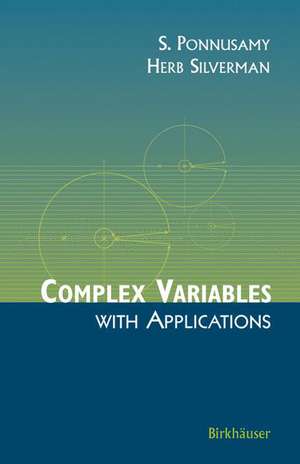Complex Variables with Applications
Autor Saminathan Ponnusamy, Herb Silvermanen Limba Engleză Hardback – 13 sep 2006
The engaging exposition is replete with discussions, remarks, questions, and exercises, motivating not only understanding on the part of the reader, but also developing the tools needed to think critically about mathematical problems. The material includes numerous examples and applications relevant to engineering students, along with some techniques to evaluate various types of integrals. The book may serve as a text for an undergraduate coursein complex variables. The only prerequisite is a basic knowledge of advanced calculus. The presentation is also ideally suited for self-study.
Preț: 587.20 lei
Preț vechi: 690.83 lei
-15% Nou
Puncte Express: 881
Preț estimativ în valută:
112.40€ • 117.99$ • 92.85£
112.40€ • 117.99$ • 92.85£
Carte tipărită la comandă
Livrare economică 30 ianuarie-13 februarie 25
Preluare comenzi: 021 569.72.76
Specificații
ISBN-13: 9780817644574
ISBN-10: 0817644571
Pagini: 513
Ilustrații: XIV, 514 p.
Dimensiuni: 155 x 235 x 29 mm
Greutate: 0.84 kg
Ediția:2006
Editura: Birkhäuser Boston
Colecția Birkhäuser
Locul publicării:Boston, MA, United States
ISBN-10: 0817644571
Pagini: 513
Ilustrații: XIV, 514 p.
Dimensiuni: 155 x 235 x 29 mm
Greutate: 0.84 kg
Ediția:2006
Editura: Birkhäuser Boston
Colecția Birkhäuser
Locul publicării:Boston, MA, United States
Public țintă
Lower undergraduateCuprins
Algebraic and Geometric Preliminaries.- Topological and Analytic Preliminaries.- Bilinear Transformations and Mappings.- Elementary Functions.- Analytic Functions.- Power Series.- Complex Integration and Cauchy’s Theorem.- Applications of Cauchy’s Theorem.- Laurent Series and the Residue Theorem.- Harmonic Functions.- Conformal Mapping and the Riemann Mapping Theorem.- Entire and Meromorphic Functions.- Analytic Continuation.
Notă biografică
Textul de pe ultima copertă
Complex numbers can be viewed in several ways: as an element in a field, as a point in the plane, and as a two-dimensional vector. Examined properly, each perspective provides crucial insight into the interrelations between the complex number system and its parent, the real number system. The authors explore these relationships by adopting both generalization and specialization methods to move from real variables to complex variables, and vice versa, while simultaneously examining their analytic and geometric characteristics, using geometry to illustrate analytic concepts and employing analysis to unravel geometric notions.
The engaging exposition is replete with discussions, remarks, questions, and exercises, motivating not only understanding on the part of the reader, but also developing the tools needed to think critically about mathematical problems. This focus involves a careful examination of the methods and assumptions underlying various alternative routes thatlead to the same destination.
The material includes numerous examples and applications relevant to engineering students, along with some techniques to evaluate various types of integrals. The book may serve as a text for an undergraduate course in complex variables designed for scientists and engineers or for mathematics majors interested in further pursuing the general theory of complex analysis. The only prerequisite is a basic knowledge of advanced calculus. The presentation is also ideally suited for self-study.
The engaging exposition is replete with discussions, remarks, questions, and exercises, motivating not only understanding on the part of the reader, but also developing the tools needed to think critically about mathematical problems. This focus involves a careful examination of the methods and assumptions underlying various alternative routes thatlead to the same destination.
The material includes numerous examples and applications relevant to engineering students, along with some techniques to evaluate various types of integrals. The book may serve as a text for an undergraduate course in complex variables designed for scientists and engineers or for mathematics majors interested in further pursuing the general theory of complex analysis. The only prerequisite is a basic knowledge of advanced calculus. The presentation is also ideally suited for self-study.
Caracteristici
Explores the interrelations between real and complex numbers by adopting both generalization and specialization methods to move between them, while simultaneously examining their analytic and geometric characteristics Engaging exposition with discussions, remarks, questions, and exercises to motivate understanding and critical thinking skills Encludes numerous examples and applications relevant to science and engineering students
















